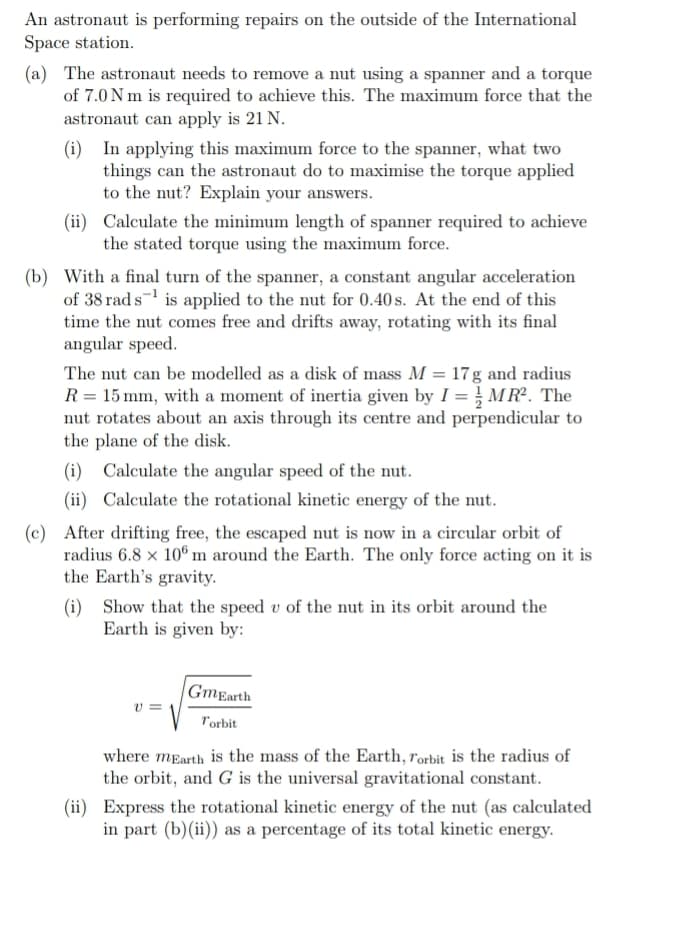An astronaut is performing repairs on the outside of the International Space station. (a) The astronaut needs to remove a nut using a spanner and a torque of 7.0 Nm is required to achieve this. The maximum force that the astronaut can apply is 21 N. (i) In applying this maximum force to the spanner, what two things can the astronaut do to maximise the torque applied to the nut? Explain your answers. (ii) Calculate the minimum length of spanner required to achieve the stated torque using the maximum force. (b) With a final turn of the spanner, a constant angular acceleration of 38 rad s¹ is applied to the nut for 0.40 s. At the end of this time the nut comes free and drifts away, rotating with its final angular speed. The nut can be modelled as a disk of mass M = 17g and radius R = 15 mm, with a moment of inertia given by I=MR². The nut rotates about an axis through its centre and perpendicular to the plane of the disk. (i) Calculate the angular speed of the nut. (ii) Calculate the rotational kinetic energy of the nut. (c) After drifting free, the escaped nut is now in a circular orbit of radius 6.8 x 106 m around the Earth. The only force acting on it is the Earth's gravity. (i) Show that the speed u of the nut in its orbit around the Earth is given by: GmEarth Torbit where mEarth is the mass of the Earth, Torbit is the radius of the orbit, and G is the universal gravitational constant. (ii) Express the rotational kinetic energy of the nut (as calculated in part (b)(ii)) as a percentage of its total kinetic energy.
An astronaut is performing repairs on the outside of the International Space station. (a) The astronaut needs to remove a nut using a spanner and a torque of 7.0 Nm is required to achieve this. The maximum force that the astronaut can apply is 21 N. (i) In applying this maximum force to the spanner, what two things can the astronaut do to maximise the torque applied to the nut? Explain your answers. (ii) Calculate the minimum length of spanner required to achieve the stated torque using the maximum force. (b) With a final turn of the spanner, a constant angular acceleration of 38 rad s¹ is applied to the nut for 0.40 s. At the end of this time the nut comes free and drifts away, rotating with its final angular speed. The nut can be modelled as a disk of mass M = 17g and radius R = 15 mm, with a moment of inertia given by I=MR². The nut rotates about an axis through its centre and perpendicular to the plane of the disk. (i) Calculate the angular speed of the nut. (ii) Calculate the rotational kinetic energy of the nut. (c) After drifting free, the escaped nut is now in a circular orbit of radius 6.8 x 106 m around the Earth. The only force acting on it is the Earth's gravity. (i) Show that the speed u of the nut in its orbit around the Earth is given by: GmEarth Torbit where mEarth is the mass of the Earth, Torbit is the radius of the orbit, and G is the universal gravitational constant. (ii) Express the rotational kinetic energy of the nut (as calculated in part (b)(ii)) as a percentage of its total kinetic energy.
Related questions
Question
Do all parts urgnt required

Transcribed Image Text:An astronaut is performing repairs on the outside of the International
Space station.
(a) The astronaut needs to remove a nut using a spanner and a torque
of 7.0 Nm is required to achieve this. The maximum force that the
astronaut can apply is 21 N.
(i) In applying this maximum force to the spanner, what two
things can the astronaut do to maximise the torque applied
to the nut? Explain your answers.
(ii) Calculate the minimum length of spanner required to achieve
the stated torque using the maximum force.
(b) With a final turn of the spanner, a constant angular acceleration
of 38 rad s¹ is applied to the nut for 0.40s. At the end of this
time the nut comes free and drifts away, rotating with its final
angular speed.
The nut can be modelled as a disk of mass M = 17g and radius
R = 15 mm, with a moment of inertia given by I = MR². The
nut rotates about an axis through its centre and perpendicular to
the plane of the disk.
(i) Calculate the angular speed of the nut.
(ii) Calculate the rotational kinetic energy of the nut.
(c) After drifting free, the escaped nut is now in a circular orbit of
radius 6.8 x 106 m around the Earth. The only force acting on it is
the Earth's gravity.
(i) Show that the speed u of the nut in its orbit around the
Earth is given by:
V=
GmEarth
Torbit
where mEarth is the mass of the Earth, Torbit is the radius of
the orbit, and G is the universal gravitational constant.
(ii) Express the rotational kinetic energy of the nut (as calculated
in part (b)(ii)) as a percentage of its total kinetic energy.
Expert Solution
This question has been solved!
Explore an expertly crafted, step-by-step solution for a thorough understanding of key concepts.
Step by step
Solved in 4 steps with 3 images
